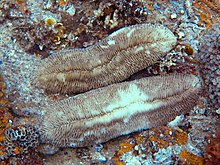Herpolitha: Difference between revisions
Cwmhiraeth (talk | contribs) Adding description |
Cwmhiraeth (talk | contribs) Adding distribution |
||
| Line 35: | Line 35: | ||
==Description== |
==Description== |
||
A [[Colony (biology)|colony]] of ''Herpolitha limax'' is an elongated structure with somewhat rounded ends and a single central axial furrow. In the furrow are many [[corallite]]s and there are irregularly spaced corallites elsewhere. The primary [[Septum (coral)|septa]] are finely-toothed and do not reach the edge of the colony but secondary septacostae do. Sometimes the furrow is forked and forms a "Y" shape or a "T" shape, or even an "X" shape, and occasionally they are domed. The colonies can grow to about {{convert|45|cm|0|abbr=on}} long and {{convert|10|to|15|cm|0|abbr=on}} wide and are usually some shade of grey or brown.<ref name=worms/><ref name=aims>{{cite web |url=http://coral.aims.gov.au/factsheet.jsp?speciesCode=0213 |title=''Herpolitha limax'' |year=2013 |publisher=Australian Institute of Marine Science |accessdate=2015-04-29}}</ref><ref name=Sprung>{{cite book |title=Corals: A quick reference guide |last=Sprung |first=Julian |year=1999 |publisher=Ricordea Publishing |isbn=1-883693-09-8 |page=57 }}</ref> |
A [[Colony (biology)|colony]] of ''Herpolitha limax'' is an elongated structure with somewhat rounded ends and a single central axial furrow. In the furrow are many [[corallite]]s and there are irregularly spaced corallites elsewhere. The primary [[Septum (coral)|septa]] are finely-toothed and do not reach the edge of the colony but secondary septacostae do. Sometimes the furrow is forked and forms a "Y" shape or a "T" shape, or even an "X" shape, and occasionally they are domed. The colonies can grow to about {{convert|45|cm|0|abbr=on}} long and {{convert|10|to|15|cm|0|abbr=on}} wide and are usually some shade of grey, brown or greenish-brown.<ref name=worms/><ref name=aims>{{cite web |url=http://coral.aims.gov.au/factsheet.jsp?speciesCode=0213 |title=''Herpolitha limax'' |year=2013 |publisher=Australian Institute of Marine Science |accessdate=2015-04-29}}</ref><ref name=Sprung>{{cite book |title=Corals: A quick reference guide |last=Sprung |first=Julian |year=1999 |publisher=Ricordea Publishing |isbn=1-883693-09-8 |page=57 }}</ref> |
||
==Distribution== |
|||
''Herpolitha limax'' is native to the Indo-Pacific region, its range extending from East Africa and the Red Sea to Australia, Indonesia, Papua New Guinea and the South Central Pacific. It is found on reef slopes and in lagoons, often in close proximity to ''[[Fungia]]'' spp.<ref name=aims/> |
|||
==References== |
==References== |
||
Revision as of 19:50, 29 April 2015
| Herpolitha limax | |
|---|---|

| |
| Scientific classification | |
| Kingdom: | |
| Phylum: | |
| Class: | |
| Order: | |
| Family: | |
| Genus: | Herpolitha Eschscholtz, 1825 [1]
|
| Species: | H. limax
|
| Binomial name | |
| Herpolitha limax | |
| Synonyms[2] | |
| |
Herpolitha is a monotypic genus of corals in the family Fungiidae. The only member of the genus is Herpolitha limax, commonly known as the tongue, slipper, mole or striate boomerang coral. It is a free-living species and is native to reefs in the Indo-Pacific region.
Description
A colony of Herpolitha limax is an elongated structure with somewhat rounded ends and a single central axial furrow. In the furrow are many corallites and there are irregularly spaced corallites elsewhere. The primary septa are finely-toothed and do not reach the edge of the colony but secondary septacostae do. Sometimes the furrow is forked and forms a "Y" shape or a "T" shape, or even an "X" shape, and occasionally they are domed. The colonies can grow to about 45 cm (18 in) long and 10 to 15 cm (4 to 6 in) wide and are usually some shade of grey, brown or greenish-brown.[2][3][4]
Distribution
Herpolitha limax is native to the Indo-Pacific region, its range extending from East Africa and the Red Sea to Australia, Indonesia, Papua New Guinea and the South Central Pacific. It is found on reef slopes and in lagoons, often in close proximity to Fungia spp.[3]
References
- ^ Hoeksema, Bert (2015). "Herpolitha Eschscholtz, 1825". WoRMS. World Register of Marine Species. Retrieved 2015-04-29.
- ^ a b c Hoeksema, Bert (2015). "Herpolitha limax (Esper, 1797)". WoRMS. World Register of Marine Species. Retrieved 2015-04-29.
- ^ a b "Herpolitha limax". Australian Institute of Marine Science. 2013. Retrieved 2015-04-29.
- ^ Sprung, Julian (1999). Corals: A quick reference guide. Ricordea Publishing. p. 57. ISBN 1-883693-09-8.
